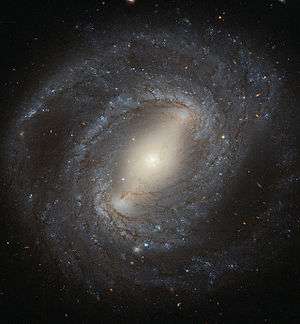NGC 4394
Coordinates: ![]() 12h 25m 55.624s, +18° 12′ 50.13″
12h 25m 55.624s, +18° 12′ 50.13″
| NGC 4394 | |
|---|---|
|
NGC 4394 taken by Hubble Space Telescope.[1] | |
| Observation data (J2000 epoch) | |
| Right ascension | 12h 25m 55.624s[2] |
| Declination | +18° 12′ 50.13″[2] |
| Redshift | 0.003075[3] |
| Helio radial velocity | 922±4 km/s[4] |
| Galactocentric velocity | 886±4 km/s[2] |
| Distance | 39.5±2.9 Mly (12.1±0.9 Mpc)[4] |
| Apparent magnitude (V) | 10.9[4] |
| Apparent magnitude (B) | 11.9[2] |
| Absolute magnitude (V) | -20.49[4] |
| Characteristics | |
| Type | SBb / (R)SB(r)b[4] |
| Size | 41.2×38.8 kly (12.7×11.3 kpc)[4] |
| Apparent size (V) | 3.6′×3.2′[4][3] |
| Other designations | |
| NGC 4394, UGC 7523, PGC 40614, MCG+03-32-035[3] | |
NGC 4394 is a SBb barred spiral galaxy in the constellation Coma Berenices and is situated about 39.5 million light-years (12.1 megaparsecs) from Earth.[4] It was discovered on 14th March 1784 by the German–British astronomer William Herschel.[3] It is a presumed companion to the lenticular galaxy M85 / NGC 4382, which lies 8 arc minutes away.[3]
References
| Wikimedia Commons has media related to NGC 4394. |
This article is issued from Wikipedia - version of the 6/14/2016. The text is available under the Creative Commons Attribution/Share Alike but additional terms may apply for the media files.
